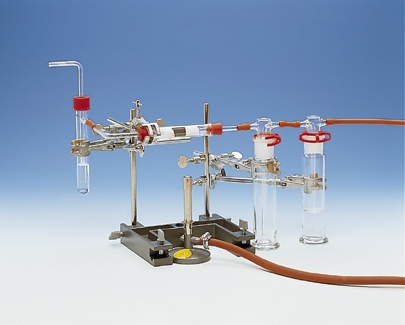Principle
In the presence of a suitable catalyst and while giving off heat, ammonia-air mixtures burn and form nitrogen monoxide and water. Nitrogen monoxide reacts immediately with the excess oxygen, thereby forming nitrogen dioxide.At higher temperatures, nitrogen monoxide is decomposed into nitrogen and oxygen. In the presence of water and oxygen, nitrogen dioxide forms nitric acid. On a large industrial scale, the combustion of ammonia with atmospheric oxygen is performed under contact with platinum (Ostwald process).
Benefits
- Introduction to the Ostwald process
- Practical water jet pump for easy generation of the required negative pressure
- Stable and safe setup due to solid stand material
Tasks
Burn an ammonia-air mixture in the presence of a catalyst (platinum-palladium-aluminium-oxide beads) and prove the resulting nitrogen oxide.
Learning objectives
- Ostwald process
- Ammonia
- Nitrogen dioxide
- Nitrogen monoxide
- Nitric acid

